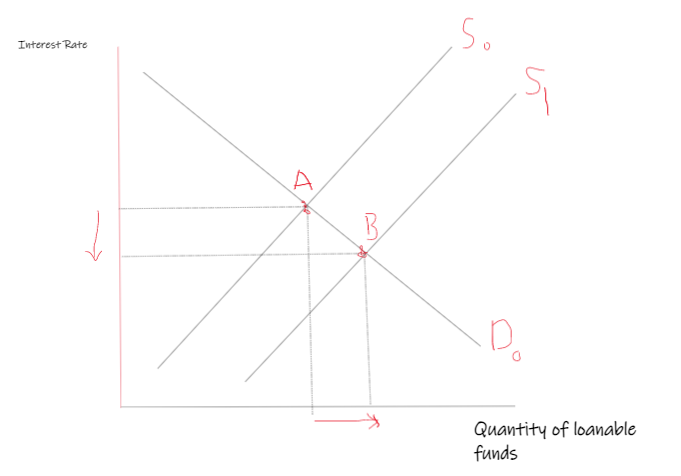5. The market for loanable funds and government policy The following graph shows the market for loanable funds. For each of the given scenarios, adjust the appropriate curve on the graph to help you complete the questions that follow. Treat each scenario separately by resetting the graph to its original state before examining the effect of each individual scenario. (Note: You will not be graded on any changes you make to the graph.) - cent) Supply Demand 10
5. The market for loanable funds and government policy The following graph shows the market for loanable funds. For each of the given scenarios, adjust the appropriate curve on the graph to help you complete the questions that follow. Treat each scenario separately by resetting the graph to its original state before examining the effect of each individual scenario. (Note: You will not be graded on any changes you make to the graph.) - cent) Supply Demand 10
Chapter1: Making Economics Decisions
Section: Chapter Questions
Problem 1QTC
Related questions
Question

Transcribed Image Text:5. The market for loanable funds and government policy
The following graph shows the market for loanable funds. For each of the given scenarios, adjust the appropriate curve on the graph to help you
complete the questions that follow. Treat each scenario separately by resetting the graph to its original state before examining the effect of each
individual scenario. (Note: You will not be graded on any changes you make to the graph.)
INTEREST RATE (Percent)
I
Demand
LOANABLE FUNDS (Billions of dollars)
Supply
Demand
Supply
*

Transcribed Image Text:Scenario 1: Individual Retirement Accounts (IRAS) allow people to shelter some of their income from taxation. Suppose the maximum annual
contribution to such accounts is $5,000 per person. Now suppose there is an increase in the maximum contribution, from $5,000 to $8,000 per year.
Shift the appropriate curve on the graph to reflect this change.
This change in the tax treatment of saving causes the equilibrium interest rate in the market for loanable funds to
spending to
Scenario 2: An investment tax credit effectively lowers the tax bill of any firm that purchases new capital in the relevant time period. Suppose the
government repeals a previously existing investment tax credit.
Shift the appropriate curve on the graph to reflect this change.
The repeal of the previously existing tax credit causes the interest rate to
This change in spending causes the government to run a budget
Scenario 3: Initially, the government's budget is balanced; then the government responds to the conclusion of a war by significantly reducing defense
spending without changing taxes.
Shift the appropriate curve on the graph to reflect this change.
and the level of saving to
This causes the interest rate to
which
and the level of investment
the level of investment spending.
national saving.
Expert Solution
Scenario _1
If the maximum annual contribution to the individual retirement accounts, it will incentivize people to put more money in their retirement account. We are assuming that people who are managing this funds use this fund to make investments and give loans. Hence the supply of the loanable funds would increase. With the given level of demand, this would lead to excess supply of loanable funds => lower the interest rate .
As we can see in the below diagram, this will lead to shift the supply curve to the right and hence at the new equilibrium we have higher quantity of loanable funds and the lower interest rate.

Step by step
Solved in 3 steps with 2 images

Knowledge Booster
Learn more about
Need a deep-dive on the concept behind this application? Look no further. Learn more about this topic, economics and related others by exploring similar questions and additional content below.Recommended textbooks for you


Principles of Economics (12th Edition)
Economics
ISBN:
9780134078779
Author:
Karl E. Case, Ray C. Fair, Sharon E. Oster
Publisher:
PEARSON

Engineering Economy (17th Edition)
Economics
ISBN:
9780134870069
Author:
William G. Sullivan, Elin M. Wicks, C. Patrick Koelling
Publisher:
PEARSON


Principles of Economics (12th Edition)
Economics
ISBN:
9780134078779
Author:
Karl E. Case, Ray C. Fair, Sharon E. Oster
Publisher:
PEARSON

Engineering Economy (17th Edition)
Economics
ISBN:
9780134870069
Author:
William G. Sullivan, Elin M. Wicks, C. Patrick Koelling
Publisher:
PEARSON

Principles of Economics (MindTap Course List)
Economics
ISBN:
9781305585126
Author:
N. Gregory Mankiw
Publisher:
Cengage Learning

Managerial Economics: A Problem Solving Approach
Economics
ISBN:
9781337106665
Author:
Luke M. Froeb, Brian T. McCann, Michael R. Ward, Mike Shor
Publisher:
Cengage Learning

Managerial Economics & Business Strategy (Mcgraw-…
Economics
ISBN:
9781259290619
Author:
Michael Baye, Jeff Prince
Publisher:
McGraw-Hill Education